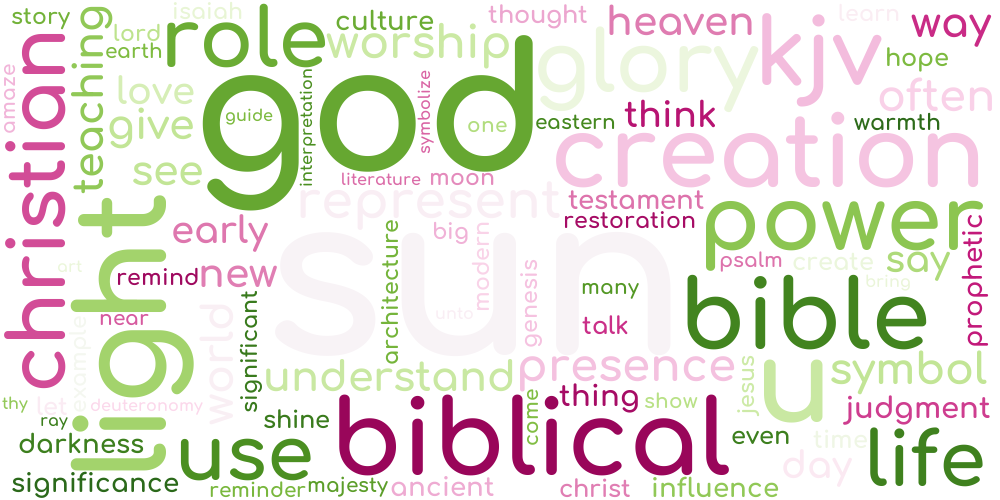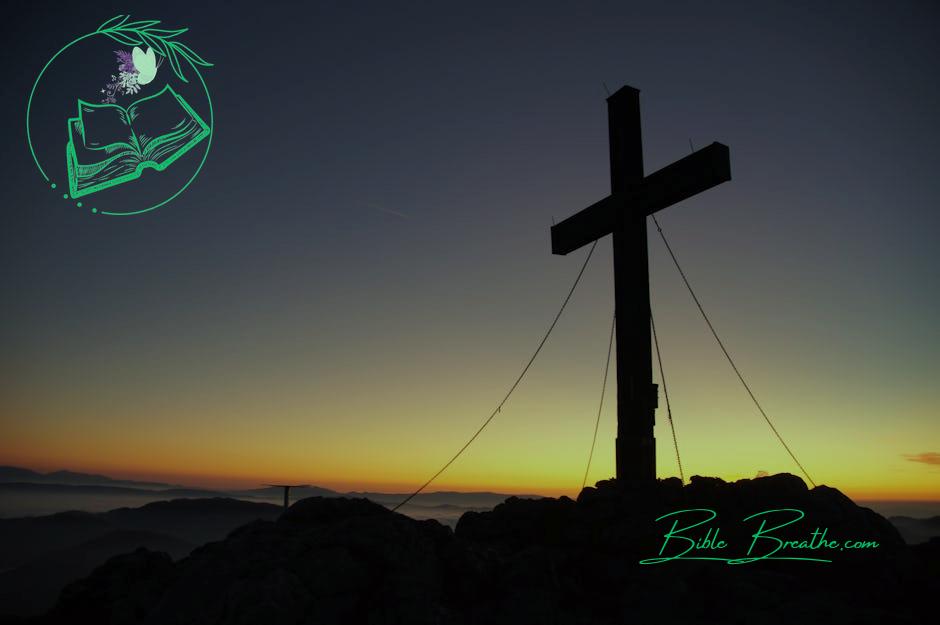Key Takeaways
- The Bible mentions the sun numerous times, often using it as a symbol of God’s power and glory (Psalm 84:11, Isaiah 60:20).
- In the book of Genesis, the sun is described as one of the lights created by God on the fourth day of creation (Genesis 1:14-19).
- The Bible also describes the sun as a means of telling time and marking the passage of seasons (Genesis 1:14, Psalm 104:19-23).
- In the book of Joshua, the sun is said to have stood still during a battle, allowing the Israelites to defeat their enemies (Joshua 10:12-14).
- The Bible also warns against worshiping the sun or other celestial bodies, as this is considered idolatry (Deuteronomy 4:19, 2 Kings 23:5).
- The ancient Israelites used a solar calendar, with the year beginning in the spring, around the time of the vernal equinox, as described in The Hebrew calendar.
Introduction
Brief Overview of the Topic
Let’s talk about the sun. We all know it’s that big ball of hot, glowing gas in the sky, but have you ever stopped to think about what the Bible says about it?
The sun is mentioned over 160 times in the Bible, so it’s definitely a significant topic. From creation to judgment, the sun plays a role in many biblical stories and teachings.
Importance of Understanding Biblical Teachings About the Sun
So, why is it important to understand what the Bible says about the sun? Well, for one thing, it can help us appreciate God’s creation. The sun is an amazing part of our world, and learning about it from a biblical perspective can deepen our understanding of God’s power and majesty.
| Reason | Why It Matters |
|---|---|
| Appreciate God’s creation | The sun is an amazing part of our world, and learning about it from a biblical perspective can deepen our understanding of God’s power and majesty. |
| Understand biblical symbolism | The sun is often used as a symbol in the Bible, representing things like God’s presence, guidance, and judgment. |
As we explore what the Bible says about the sun, I hope you’ll join me on this journey of discovery. Who knows what we’ll learn?
Before we proceed, take a look at this word cloud to get a sense of the key themes.
Word cloud by BibleBreathe.com about what does the bible say about the sun
The Sun in the Creation Story
Photo modified by BibleBreathe.com. Original photo by Darwis Alwan on Pexels
The Sun’s Role in the Creation of the World
Let’s dive into the creation story and see what the Bible says about the sun.
In Genesis 1:14-19, we read about God creating the sun, moon, and stars on the fourth day.
| Day | Creation |
|---|---|
| 1 | Light |
| 2 | Sky |
| 3 | Land and sea |
The sun was created to give light upon the earth, to divide the day from the night, and to serve as a sign for seasons and days.
It’s pretty cool to think about how the sun has been doing its job for thousands of years, providing us with warmth, light, and a way to keep track of time.
The Significance of the Sun in the Creation Story
So, why is the sun such a big deal in the creation story?
Well, for one, it shows us God’s power and creativity. I mean, think about it – God just spoke, and the sun appeared!
It also reminds us of God’s love and care for us. The sun is essential for our survival, and God provided it for us.
As Psalm 19:1 says, “The heavens declare the glory of God; and the firmament sheweth his handywork.” (KJV)
The sun is just one example of God’s amazing creation, and it points us to His greatness and love.
As the famous astronomer, Galileo Galilei, once said, “The Bible shows the way to go to heaven, not the way the heavens go.
The sun might just be a big ball of hot, glowing gas to some people, but to us as Christians, it’s a reminder of God’s amazing creation and love for us.
The Sun in Ancient Near Eastern Cultures
The Sun’s Role in Biblical and Other Ancient Near Eastern Cultures
Let’s talk about the sun in ancient times.
In many ancient Near Eastern cultures, the sun was considered a god or a symbol of divine power.
| Culture | Sun’s Role |
|---|---|
| Egyptian | The sun god Ra was considered the most important deity. |
| Mesopotamian | The sun god Shamash was the god of justice and righteousness. |
Influence of Ancient Near Eastern Cultures on Biblical Teachings
So, how did these cultures influence biblical teachings about the sun?
Here are a few examples:
- Solar imagery in the Bible: The Bible uses solar imagery to describe God’s glory and power (Psalm 84:11, KJV).
- The sun as a symbol of God’s presence: In the Bible, the sun is often associated with God’s presence and blessing (Deuteronomy 33:2, KJV).
- Warning against sun worship: The Bible warns against worshiping the sun or other created things (Deuteronomy 4:19, KJV).
“The heavens declare the glory of God; and the firmament sheweth his handywork.” (Psalm 19:1, KJV)
“And beware lest thou lift up thine eyes unto heaven, and when thou seest the sun, and the moon, and the stars, even all the host of heaven, shouldest be driven to worship them, and serve them…” (Deuteronomy 4:19, KJV)
The Sun in Old Testament Prophetic Literature
Photo modified by BibleBreathe.com. Original photo by Bradley Hook on Pexels
The Use of the Sun as a Symbol in Prophetic Literature
The sun is more than just a big ball of hot, glowing gas in the sky – it’s also a powerful symbol in the Bible.
In Old Testament prophetic literature, the sun is often used to represent God’s presence, power, and judgment.
Think about it: just like the sun is the center of our solar system, God is the center of our lives.
And just as the sun’s rays can bring life and warmth, or scorching heat and destruction, God’s presence can bring blessing or judgment.
| Prophetic Book | Symbolic Use of the Sun |
|---|---|
| Isaiah | The sun is used to represent God’s glory and judgment (Isaiah 24:23, 30:26) |
| Ezekiel | The sun is used to symbolize God’s presence and power (Ezekiel 1:4, 8:2) |
The Significance of the Sun in Prophetic Visions and Messages
So, what can we learn from the sun’s appearance in prophetic visions and messages?
Here are three key takeaways:
- God’s glory is awe-inspiring: The sun is often used to describe God’s glory and majesty in prophetic literature. This reminds us of the awe-inspiring nature of God’s presence.
- God’s judgment is real: The sun is also used to symbolize God’s judgment and wrath. This serves as a reminder of the seriousness of sin and the importance of repentance.
- God’s restoration is possible: Finally, the sun is used to represent God’s healing and restoration. This gives us hope for a brighter future, even in the midst of darkness and struggle.
“The sun shall no more be thy light by day; neither for brightness shall the moon give light unto thee: but the Lord shall be unto thee an everlasting light, and thy God thy glory.” (Isaiah 60:19, KJV)
The Sun in the New Testament
The Sun’s Role in the New Testament
The sun plays a significant role in the New Testament, often symbolizing God’s presence and blessings. Let’s take a look at some examples.
| New Testament Reference | Significance of the Sun |
|---|---|
| Matthew 13:43 | The sun represents the kingdom of heaven, where the righteous will shine. |
| John 11:9 | Jesus refers to Himself as the light of the world, just like the sun is the light of our world. |
The Significance of the Sun in the Teachings of Jesus and the Apostles
The sun is also used in the New Testament to illustrate spiritual truths. For example, Jesus teaches that just as the sun rises and sets, so too will the day of the Lord come unexpectedly (Matthew 24:27).
“Then shall the righteous shine forth as the sun in the kingdom of their Father.” (Matthew 13:43, KJV)
The apostle Paul also uses the sun to describe the ** transforming power of God’s love**. Just as the sun’s rays can change the darkness, so too can God’s love transform our lives (2 Corinthians 3:18).
“But we all, with open face beholding as in a glass the glory of the Lord, are changed into the same image from glory to glory, even as by the Spirit of the Lord.” (2 Corinthians 3:18, KJV)
The Sun in Early Christian Thought
Photo modified by BibleBreathe.com. Original photo by Pixabay on Pexels
The Sun’s Role in Early Christian Theology
Let’s talk about the sun in early Christian thought.
It’s interesting to see how early Christians viewed the sun and its significance in their theology.
The sun was often seen as a symbol of Christ, the light of the world.
This makes sense, given Jesus’ own words: “I am the light of the world: he that followeth me shall not walk in darkness, but shall have the light of life” (John 8:12, KJV).
| Early Christian Symbolism | How the Sun Relates |
|---|---|
| Christ as the light of the world | The sun represents Christ’s illuminating presence in our lives. |
| God’s power and majesty | The sun’s incredible energy and size remind us of God’s awe-inspiring power. |
The Influence of Early Christian Thought on Modern Interpretations of the Sun
So, how does this early Christian thought influence our modern understanding of the sun?
Here are a few ways:
- We see the sun as a reminder of God’s presence: Just as the early Christians did, we can view the sun as a symbol of Christ’s presence in our lives.
- We appreciate the sun’s role in creation: The sun’s energy is essential for life on earth, reminding us of God’s incredible creation.
- We’re inspired by the sun’s beauty: The sun’s beauty can evoke a sense of wonder and awe, pointing us to the even greater beauty of God’s character.
For God, who commanded the light to shine out of darkness, hath shined in our hearts, to give the light of the knowledge of the glory of God in the face of Jesus Christ” (2 Corinthians 4:6, KJV).
The Sun in Modern Interpretations
The Sun’s Role in Modern Biblical Interpretations
When we think about the sun, we might not immediately think about the Bible. But, the sun plays a significant role in modern biblical interpretations.
In many Christian traditions, the sun is seen as a symbol of God’s love and light. It’s a reminder that God is always present, even when we can’t see Him.
But, what does the Bible actually say about the sun?
Here are a few key verses:
- “The people that walked in darkness have seen a great light: they that dwell in the land of the shadow of death, upon them hath the light shined.” (Isaiah 9:2, KJV) – This verse talks about the light of God, which is often associated with the sun.
- “And God saw the light, that it was good: and God divided the light from the darkness.” (Genesis 1:4, KJV) – This verse highlights the importance of light, which is often symbolized by the sun.
The Significance of the Sun in Contemporary Christian Thought
So, what does the sun mean to us today?
Here are a few ways the sun is significant in contemporary Christian thought:
- Hope in darkness: Just like the sun shines brightest in the darkest times, God’s love and light can shine through our struggles.
- Guidance and direction: The sun can guide us on our journey, just like God’s Word can guide us through life’s ups and downs.
- Renewal and restoration: The sun’s rays can bring new life to the world, just like God’s love can bring renewal and restoration to our lives.
“Arise, shine; for thy light is come, and the glory of the Lord is risen upon thee.” (Isaiah 60:1, KJV)
The Sun in Art and Architecture
Photo modified by BibleBreathe.com. Original photo by Alexander Grey on Pexels
The Representation of the Sun in Biblical Art and Architecture
Have you ever stopped to think about how the sun is represented in biblical art and architecture?
It’s pretty fascinating, actually.
The sun is often depicted as a symbol of God’s power and glory.
You can see this in the way ancient artists used sun imagery in their work.
For example, in the tabernacle, the embroidered garments of the high priest had sun-like decorations on them (Exodus 28:2-5).
| Symbolism | Representation |
|---|---|
| God’s power | The sun’s rays extending from the horizon |
| God’s glory | The sun’s radiant light illuminating the scene |
The Influence of Biblical Teachings on the Depiction of the Sun
So, how did biblical teachings influence the way artists depicted the sun?
Well, for one thing, the Bible emphasizes the sun as a creation of God (Genesis 1:14-19).
This understanding of the sun as a divine creation shaped the way artists represented it in their work.
The sun was often shown in a more subdued or peripheral role, highlighting God’s ultimate power and authority.
| Artistic Style | Influence of Biblical Teachings |
|---|---|
| Gothic architecture | Featured tall, soaring lines to emphasize God’s transcendence |
| Illuminated manuscripts | Showed the sun in harmonious balance with other elements |
Remember, the way we represent the sun in art and architecture reflects our understanding of God’s relationship with creation.
The Sun in Worship and Ritual
The Role of the Sun in Biblical Worship and Ritual
Let’s talk about the sun in biblical worship.
In ancient times, the sun was a big deal – people worshipped it as a god, and it played a significant role in many cultures’ rituals.
But what does the Bible say about the sun?
| Biblical Reference | Description |
|---|---|
| Psalm 19:4-6 | The sun is described as a bridegroom coming out of his chamber, rejoicing as a strong man to run a race. |
| Genesis 1:14-19 | God created the sun to give light on the earth and to separate day from night. |
The Significance of the Sun in Contemporary Christian Worship
So, what can we learn from the sun’s role in biblical worship?
Here are three key things:
- The sun is a creation, not a creator: We should worship the God who made the sun, not the sun itself.
- The sun reminds us of God’s power: Just like the sun gives us light and warmth, God gives us spiritual light and life.
- The sun is a symbol of hope: Just as the sun rises every morning, we can have hope in God’s promises and new beginnings.
“For the wrath of God is revealed from heaven against all ungodliness and unrighteousness of men, who hold the truth in unrighteousness; Because that which may be known of God is manifest in them; for God hath shewed it unto them. For the invisible things of him from the creation of the world are clearly seen, being understood by the things that are made, even his eternal power and Godhead; so that they are without excuse:” (Romans 1:18-20, KJV)
Frequently Asked Questions About What Does The Bible Say About The Sun
What Are the Different Interpretations of the Sun in the Bible?
In the Bible, the sun symbolizes God’s presence, power, and faithfulness. It can represent Jesus Christ, the light of the world, or wisdom and understanding. The sun can also signify judgment, righteousness, or a manifestation of God’s glory. Additionally, it may symbolize the Cycle of life, resurrection, and eternal life.
How Has the Bible Influenced Our Understanding of the Sun?
The Bible’s influence on our understanding of the sun is subtle yet significant. While it doesn’t provide scientific facts, it portrays the sun as a symbol of God’s power and creation. Psalms 19:4-6 describes the sun’s coursing through the sky, while Malachi 4:2 associates it with healing and restoration. These passages have inspired artistic and literary works, fostering a sense of awe and reverence for the natural world.
What Are the Different Religious Beliefs About the Sun?
Religious beliefs about the sun vary widely. In ancient Egyptian religion, the sun god Ra was worshipped as a symbol of creation and power. In Hinduism, the sun is associated with the god Surya, representing light and life. In some indigenous cultures, the sun is seen as a source of spiritual energy and renewal. In Christianity, the sun is often seen as a symbol of God’s glory and majesty.
{
“@context”: “https://schema.org”,
“@type”: “FAQPage”,
“mainEntity”: [
{
“@type”: “Question”,
“name”: “What Are the Different Interpretations of the Sun in the Bible?”,
“acceptedAnswer”: {
“@type”: “Answer”,
“text”: “In the Bible, the sun symbolizes God’s presence, power, and faithfulness. It can represent Jesus Christ, the light of the world, or wisdom and understanding. The sun can also signify judgment, righteousness, or a manifestation of God’s glory. Additionally, it may symbolize the Cycle of life, resurrection, and eternal life.”
}
},
{
“@type”: “Question”,
“name”: “How Has the Bible Influenced Our Understanding of the Sun?”,
“acceptedAnswer”: {
“@type”: “Answer”,
“text”: “The Bible’s influence on our understanding of the sun is subtle yet significant. While it doesn’t provide scientific facts, it portrays the sun as a symbol of God’s power and creation. Psalms 19:4-6 describes the sun’s coursing through the sky, while Malachi 4:2 associates it with healing and restoration. These passages have inspired artistic and literary works, fostering a sense of awe and reverence for the natural world.”
}
},
{
“@type”: “Question”,
“name”: “What Are the Different Religious Beliefs About the Sun?”,
“acceptedAnswer”: {
“@type”: “Answer”,
“text”: “Religious beliefs about the sun vary widely. In ancient Egyptian religion, the sun god Ra was worshipped as a symbol of creation and power. In Hinduism, the sun is associated with the god Surya, representing light and life. In some indigenous cultures, the sun is seen as a source of spiritual energy and renewal. In Christianity, the sun is often seen as a symbol of God’s glory and majesty.”
}
}
]
}






